The mission of Sailing World‘s Boat of the Year Awards, now more than two decades running, is to acknowledge and highlight the best in performance sailboat design, construction, and overall execution. To accomplish this enviable task each year, the editors enlist expertise from within the industry: independent experts who can see past the marketing hype and the salesmanship to validate a boat’s design and performance. They painstakingly pick each nominee apart, looking beneath floorboards and behind cabinets, and running their fingers in the crevices between stringers and hulls. Then, for five days following the U.S. Sailboat Show in Annapolis, it’s sails up and “see how they go.”
Here are the results. For more on the Boat of the Year testing, check out our January/February issue, in homes before the end of the year.
Boat of the Year: Farr 280
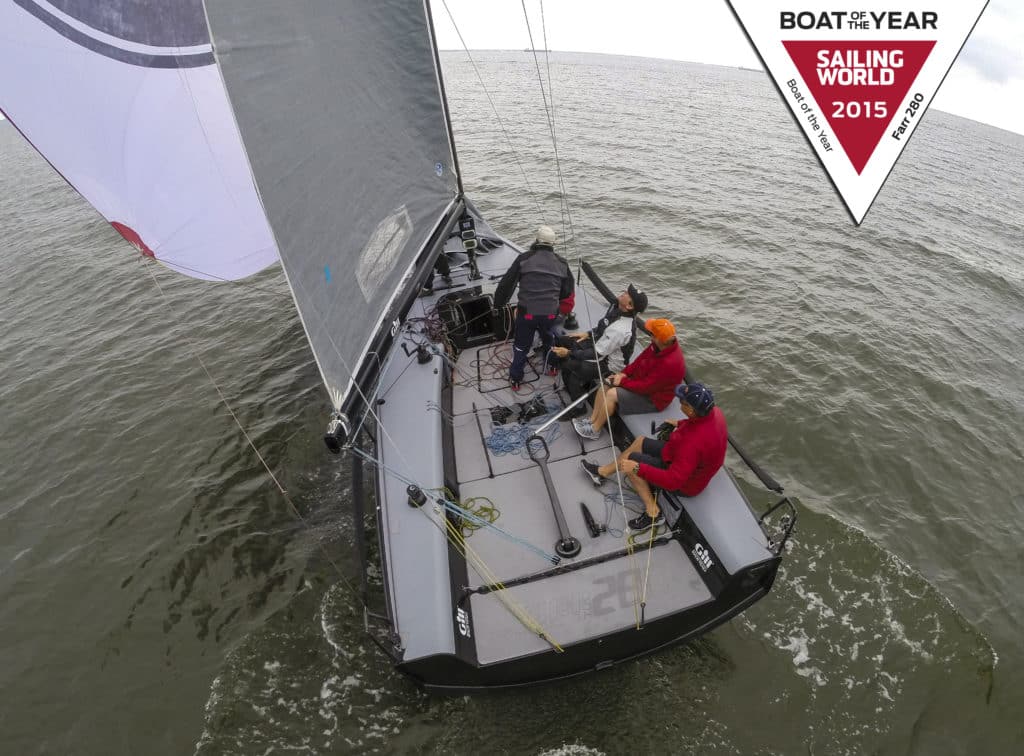
2015 Boat of the Year: Farr 280
When it comes to smaller grand-prix one-design keelboats, Farr Yacht Design once reigned supreme. Even today, two of their most notable—the Mumm 30 and Farr 40—have fleets that continue to deliver excellent class racing, well into their years. The Farr 400, a Boat of the Year finalist, and a bit of redirection for FYD, was a boat meant to be dual-purpose: a boat to take around the cans and offshore. It would seem, however, that owners really do prefer one or the other, so when it came to designing the Farr 280, the boys in Annapolis took a laser focus to deliver the most advanced, but manageable, little big-boat they could, and this time, they nailed it.
At 28 feet and only 3,600 pounds, it’s light enough to tow from regatta to regatta (keel on or off), and with a recommended crew of five or six, it’s a boat an owner can campaign on a reasonable budget. Class rules are in place, the sail inventory is fixed, and as a dynamic and technical boat on all points of sail, it’ll be fun in the light stuff, but especially good when the wind gets cranking.
“One of my favorite things about this boat is that, with the hydraulics, you can see the rig move, which teaches people how pumping it up and putting headstay on affects the helm,” said Boat of the Year judge Chuck Allen. “You can really feel it in the boat.”
“All the systems worked smoothly,” said Tom Rich. “What I like about the boat is that it’s innovative and they’re not trying to be everything to everybody. They made a grand-prix, go-fast, one-design boat, that’s it.”
“Anyone that’s used to a sophisticated dinghy will easily get into the boat and learn it quickly,” added Greg Stewart. “With the hydraulics you’d start out slowly figuring them out, but once you do, you’ll be using them all the time. They got the hull shape right in the stern, too. It’s a very clean round shape with a chine that’s high enough that the corners are never dragging.”
Allen’s account of the light-air sailing test was that it, “handles like a champ.”
“With all the little controls we could make the sails, and the boat, do what it’s suppose to do,” he said.
“It’s responsive to everything,” added Stewart. “I sense it will be easy to handle in more breeze, not so prone to wiping out because the rudder is pretty far forward and the hull shape is forgiving. When guys are tweaking things, the boat will really respond and go fast.”
DESIGNED FOR: One-design racing
REQUIRED CREW: Five to six
BEST ATTRIBUTES: Construction quality, hydraulic rig controls, modern systems and gear, road-worthy
PRICE AS TESTED: $115,000
Best dinghy: Topper Topaz Argo
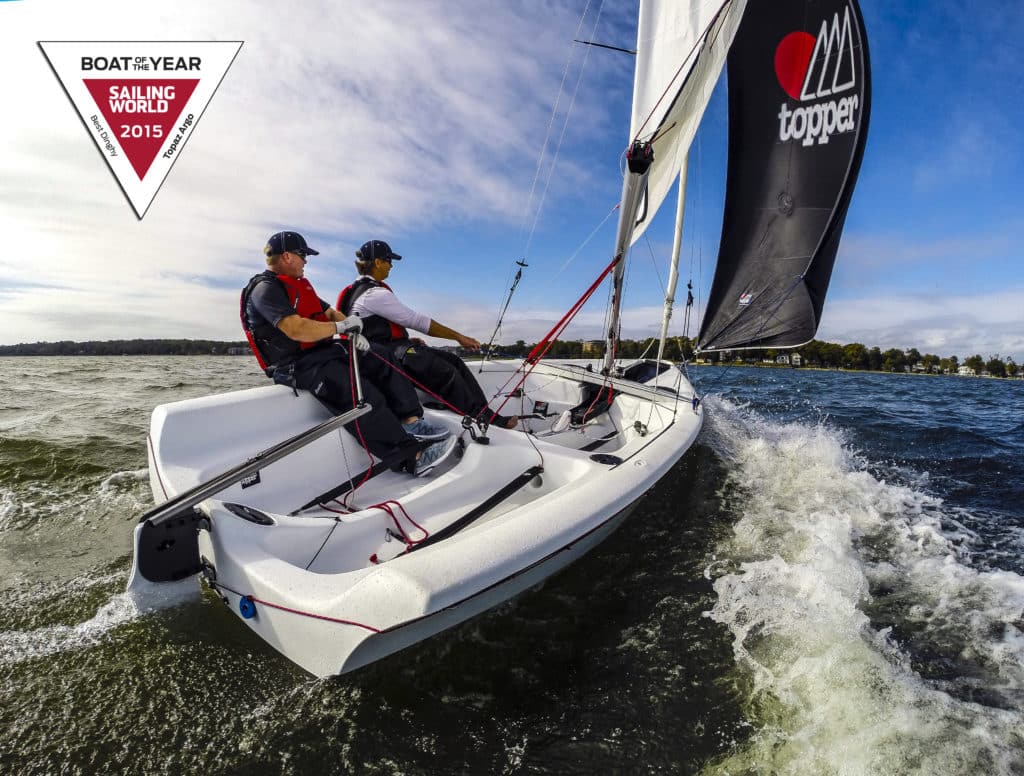
Topaz Argo: Best Dinghy
Roto-molded boats are a dime a dozen these days, but they’re essential to the base of the sport, particularly for sailing schools and community sailing programs, so getting a new model to standout is a challenge for companies like Topper. The boat has to be remarkably stiff, strong, fun to sail, and reasonably priced. The Argo, our judges agreed, hit on all four points. The Argo is only 14 feet, but it’s a generous 14 feet, with 6 feet of beam and a lot of volume. Its buoyancy was good, and seating, inside and on the coaming, was comfortable. With the Gnav vang, and the boom up high, it’s easy to get across the boat.
In 10 knots of breeze and flat water, the judges rotated through, disembarking with smiles. “The boat moves along great,” said Allen. “The hull chine works; it heels until the chine digs and then it tracks perfectly. It’s a lot stiffer than roto-molded boats we’ve sailed in the past.”
Stewart agreed: “The tiller feels good, the boat balances nicely, and it’s lively with the spinnaker. I can see younger sailors would jump in it and have a blast.”
“It’s more than a youth training boat,” concluded Allen. “We were hiked, kite up, weight back, and the thing just ripped along. Nice and stable. I’d say it’s more of an intermediate dinghy. It can be dumbed down for lessons, but with the bigger kite, two adults would have fun with it, especially with the traps.”
DESIGNED FOR: Sailing schools, families, and getting youth sailors on the wire
REQUIRED CREW: Two to race, four to play
BEST ATTRIBUTES: Proven roto-molded construction, engineered stiffness in the hull, easy but powerful sailplan
PRICE AS TESTED: $12,000
Best One-Design: RS Aero
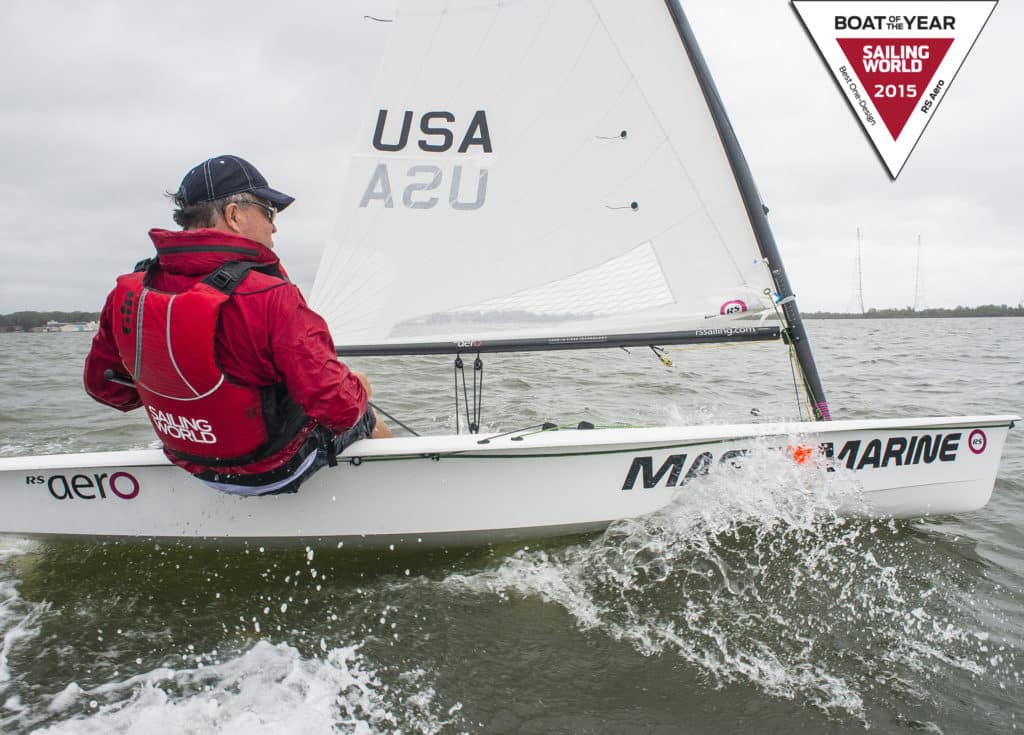
RS Aero: Best One-Design
The 13-foot RS Aero, said to be years in development, is a stunning singlehander that is more than comparable to the Laser. “The concept is to redefine sailing in its most simplest form,” said RS Sailing’s Riki Hooker. “The Aero’s development was an obsession with reducing sailing weight [to 78 pounds], which effects everything else.”
As with other past BOTY winners from RS, the boat was thoroughly engineered in every detail: from the paneled hull coring that makes the chine and minimizes resin pooling during construction, to simple and effective sail control leads, spar options, and tuning/numeral decals on the spars. Even the deck contours were considered to allow boats to be stacked more efficiently for travel and storage.
It has three sail options using different mast sections and the hull shape is sharp, modern, and fast. When it came to selecting the RS Aero as the year’s best one-design, there was no debate. “The boat is impeccable and really quick,” was Stewart’s assessment. “We keep comparing it to the Laser, and when you’re on it, it feels like one, but because it’s narrower forward, it cuts through the waves better. The mast-sail combo works beautifully.”
“What’s cool is when you’re hiking, it fits your body perfectly,” said Allen of the cockpit’s sidewalls. “It’s very clean in the boat, so it’s easy getting across.”
DESIGNED FOR: One-design racing or soul sailing
BEST ATTRIBUTES: Construction quality, lightweight hull, versatile rig with multiple combinations, technical details, and price
PRICE AS TESTED: $6,940
Best Multihull: Gunboat 55
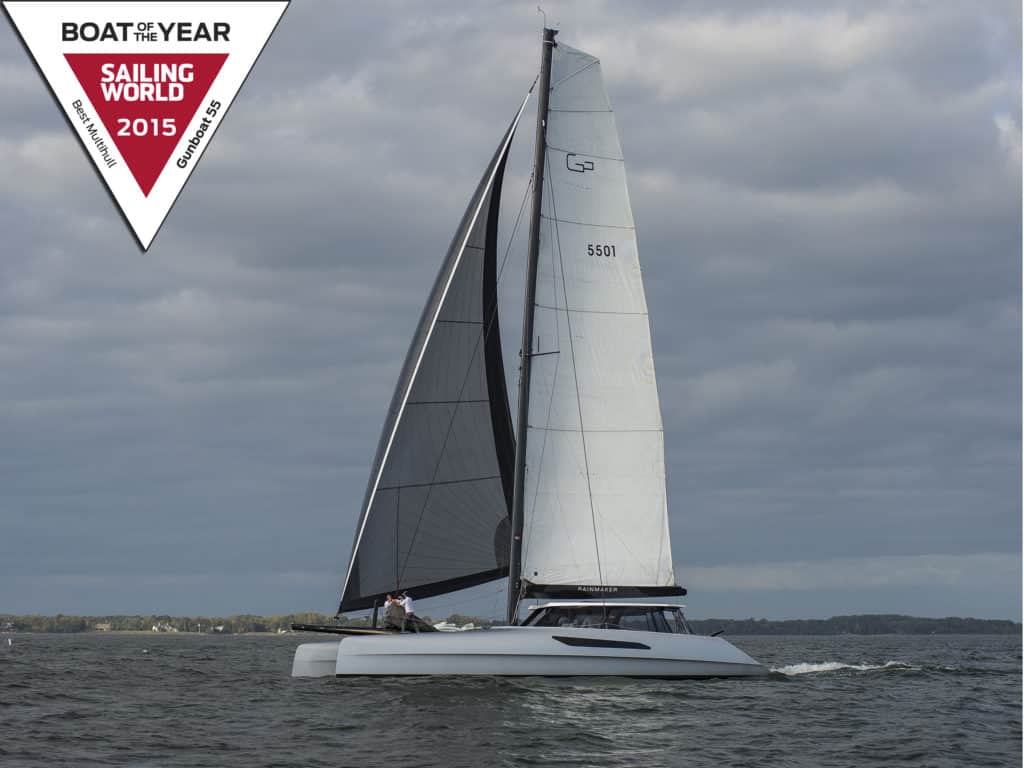
Gunboat 55: Best Multihull
As the judges stepped aboard the Gunboat 55, ducking out of a soaking rain during dockside inspections, Gunboat’s Peter Johnstone ushered them into the main salon, bone dry and balmy. The interior is one big dance floor, with a space age looking helm station at its apex. It’s a world cruising boat for a couple, said Johnstone, but he knows well t’s a raceboat, too. That’s what Gunboat owners eventually do once they get a taste of competition.
Aside from its construction, the big design difference in the 55 from previous Gunboat models is its interior winch island. “The problem with quick boats is you always have breeze on,” said Johnstone as a six-foot glass moon roof slid open with a push of a button (accompanied by a doorbell “ding-dong.”) “The apparent wind is in the mid-20s, so you need protection, but you still need to be able to see the sails and feel the elements.”
The exterior is plenty slick, with a low-profile and modern look, but the boat’s $2-million price tag lies beneath the paint: 110 layers of unidirectional carbon are infused into the thing. It’s a “ridiculously difficult boat to build,” said Johnstone. In regard to the Gunboat 55, however, the judges agreed: This is Gunboat’s crowning achievement. The look, the finish, and the sailing experience are all over the top.
“You have a few options in the interior, but essentially you’re getting a high-end production boat,” said Allen. “I’m not convinced a couple could take this on right away, but it’s a lot more manageable than anything they’ve done.”
“I have a lot of comments in my notes about how sexy it looks,” said Stewart. “There’s great styling, it’s comfortable to hang out on, and the build and paint work are spectacular. It’s an expensive boat, but it’s exactly what it should be.”
DESIGNED FOR: Fast passages, occasional class racing, and sailing off the grid
REQUIRED CREW: Five to race, two to cruise—with experience
BEST ATTRIBUTES: Best performing cruising cat of its kind; stiff, lightweight engineering, race ready, American built
PRICE AS TESTED: $2,100,000
Best Crossover: Seascape 27
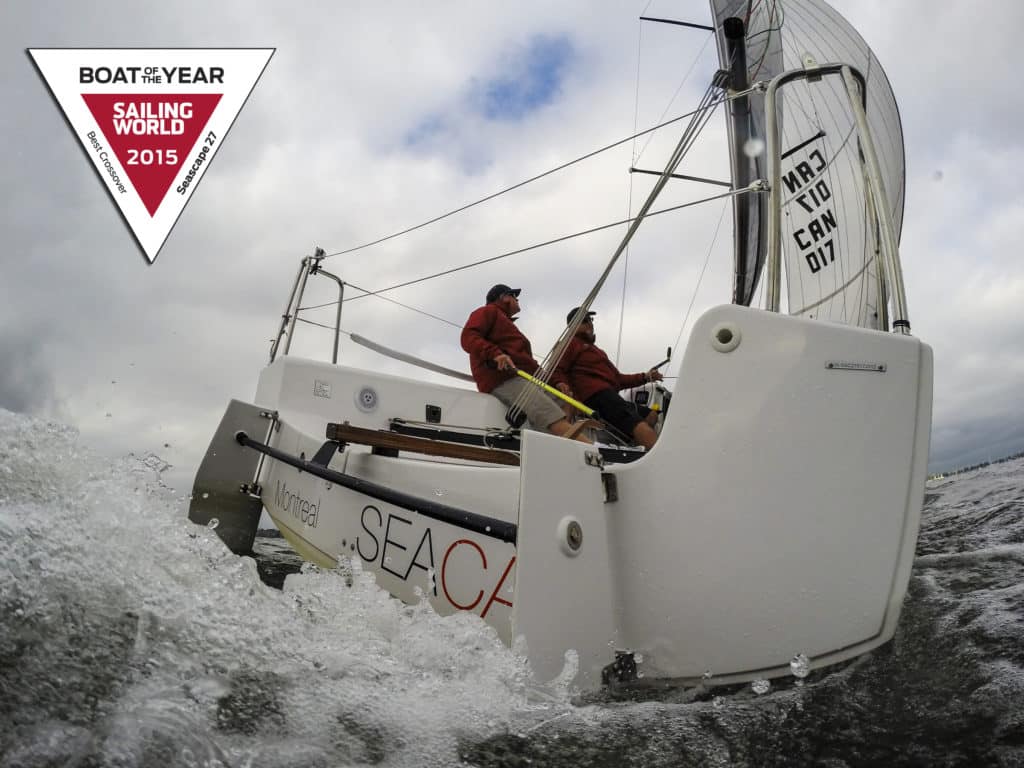
Seascape 27: Best Crossover
The Seascape 27, a modern-day trailer racer, said the judges, is the complete package. This Slovenian-built creation from a pair of Mini-Transat veterans (Samual Manard is the designer) is only 3,100 pounds, and its billed as a mini crossover. In Europe, they’re racing them one-design and offshore. It’s quick, road-ready, ocean-worthy, and perfect for weekends with the tribe. For $120,000 it’s fully loaded and racing.
The interior is an exemplary use of volume, with a retracting spinnaker bin, a head, two big and long settees, and sitting headroom. The centerboard’s manual hydraulic pump brings it home with a few pumps.
“The thing is incredible, upwind and downwind,” said Allen after sailing. “It looks great going through the water, has a nice groove with the Code Zero in light air, and there’s a lot of boat for its size. They say it’s for shorthanded coastal racing, but you’re going to race it in the weeknight series and overnight races, and be really happy with it.”
“It’s lively, and with no backstays, it’s simple, said Rich. “The construction is fine and seemed durable. There’s a lot of innovation inside the boat.”
“I echo the light-air performance,” said Stewart. I noticed right away was how clean the wake is. The chine is in the right spot and the double rudders have positive control. The big J-measurement allows a non-overlapping jib that has grunt. They didn’t cram everything into the cockpit for shorthanded sailing; it’s big enough that we weren’t tripping over each other. It’s a fantastic boat all around.”
“Really, really cool boat,” concluded Allen. “For shorthanded sailing, it’s a sweet ride.”
DESIGNED FOR: Shorthanded racing, camper cruising, and daysailing
REQUIRED CREW: Solo, twin, or four around the cans
BEST ATTRIBUTES: Innovative details, versatility, performance, trailerability, one-design class
PRICE AS TESTED: $120,000, well equipped









